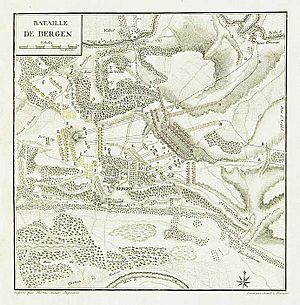Battle of Bergen (1759) facts for kids
Quick facts for kids Battle of Bergen |
|||||||
|---|---|---|---|---|---|---|---|
| Part of the Seven Years' War | |||||||
 Battle of Bergen 1759 |
|||||||
|
|||||||
| Belligerents | |||||||
Brunswick |
|||||||
| Commanders and leaders | |||||||
| Strength | |||||||
| ca 35,000 men | ca 28,000 men | ||||||
| Casualties and losses | |||||||
| 2,500 killed or wounded 300 captured |
1,800 killed or wounded | ||||||
The Battle of Bergen was a major fight during the Seven Years' War. It happened on April 13, 1759, near Frankfurt-am-Main in Germany. The French army, led by Duke de Broglie, faced off against an allied army. This allied force included soldiers from Britain, Hanover, Hesse, and Brunswick. Their leader was Prince Ferdinand of Brunswick. The battle ended with a victory for the French.
Contents
Why the Battle Happened
Prince Ferdinand's Plan
In early 1759, Prince Ferdinand wanted to surprise the French army. He moved his troops out of their winter camps in March. His goal was to capture Frankfurt, a key French base on the Main River. He hoped to push the French out of a region called Westphalia.
By the end of March, Prince Ferdinand had about 27,000 soldiers. His army was split into three main groups. He commanded one group himself. The other two were led by Prince Johann Casimir of Isenburg-Birstein and the Duke of Holstein-Gottorp.
French Preparations
Prince Ferdinand's army first took control of Fulda and Meiningen. These towns were held by an Imperial army. As this Imperial army moved back, Ferdinand headed towards Hesse. He wanted to attack the French forces led by Broglie before they could get more soldiers.
However, Broglie managed to get reinforcements. He was joined by Saxon soldiers and other French regiments. Broglie then set up his army in the strong, walled town of Bergen. He waited there for Prince Ferdinand's attack.
The Battlefield and Defenses
Bergen's Strong Position
The area around Bergen was perfect for defense. The town of Bergen itself was on a high hill next to the Main River. This meant enemies could not easily go around it.
Northwest of Bergen was a small hill called the "Berger-Warte." An old tower stood on top of this hill, giving a good view of the area. To the left of this hill was the town of Vilbel, located near the Nidda River. The land around Vilbel was covered by woods.
Broglie's Setup
Duke de Broglie placed many of his foot soldiers inside and behind Bergen. On his left side, he put his light infantry in the woods. They were supported by the Saxon soldiers and some of his cavalry.
Broglie set up most of his cannons in the middle of his lines. He had eight groups of cannons. Behind these cannons, he placed most of his cavalry and his reserve troops. These reserve troops were held in special formations, ready to move quickly.
The Battle Begins
Allied Attack
Prince Ferdinand's army arrived at the battlefield in pieces. Ferdinand himself was with the first group of soldiers. He thought the French were not fully ready yet. So, he ordered an immediate attack, without waiting for his other two groups to arrive.
Even though the odds were against them, the allied soldiers fought well. By 8:00 AM, they had captured the town of Vilbel. They also took another small hill called "Am Hohen Stein."
Fighting for Bergen
Ferdinand saw that Bergen was the most important spot. Around 8:30 AM, he ordered an attack on the town. At first, the allied attack was successful. They pushed the French soldiers out of the hedges and orchards. The French fell back into the town.
But then, Broglie sent in more soldiers. These fresh troops turned the fight around. They pushed the allied soldiers back.
Isenburg's Division Arrives
At 10:00 AM, Prince Isenburg's group of soldiers finally arrived. Isenburg immediately joined the battle. He once again pushed the French troops back into Bergen.
However, Broglie quickly counterattacked again. He used even more fresh soldiers from his reserve. This caused confusion among the allied troops and pushed them back again. Prince Isenburg himself was killed trying to get his men to fight on. Prince Ferdinand had a hard time getting his soldiers back in order.
The Battle Ends
After this, the fighting slowed down. Broglie brought his reserve troops and cavalry forward. Prince Ferdinand could now see how large the French army really was. Also, the French cannons were firing accurately, forcing the allied army back up the "Am Hohen Stein" hill.
When Holstein-Gottorp's group finally reached the battlefield, plans for another attack were stopped. The battle turned into a long cannon fight. This lasted until nightfall. Then, the allied army pulled back.
The Battle of Bergen was a clear French victory. However, Broglie did not chase Prince Ferdinand's army. This allowed Ferdinand to escape with his soldiers towards Minden.
What Happened Next
This battle was a tough loss for Prince Ferdinand. Even his brother-in-law, Frederick the Great, tried to cheer him up. But Ferdinand would recover. He and his army would later win a big victory at the Battle of Minden in the same year.
The allied army lost about 2,800 soldiers. The French lost about 1,800 soldiers. Important people who died included Prince Isenburg for the allies and Saxon General George Charles Dyhern for the French side.
More to Read
- Die Schlacht Bei Bergen Unweit Frankfurt Am Main Zwischen Den Königl. Französischen Truppen Unter Anführung Des Herzogs Von Broglio, Und Den Alliirten, Unter Den Befehlen Des Herzogs Ferdinand Von Braunschweig den 13ten April 1759 (digitalised)
- Johann Wilhelm von Archenholtz: Geschichte des siebenjährigen Krieges in Deutschland von 1756 bis 1763, Biblio-Verlag, Osnabrück, 1982, pp. 292–296. ISBN: 3-7648-1203-6 (Nachdruck der Ausgabe Karlsruhe 1791).
- Olaf Groehler: Die Kriege Friedrichs II. 5th ed. Militärverlag der DDR, Berlin, 1989, ISBN: 3-327-00038-7.

